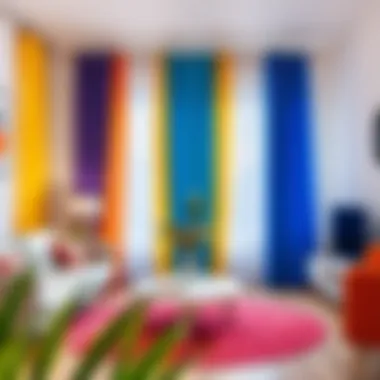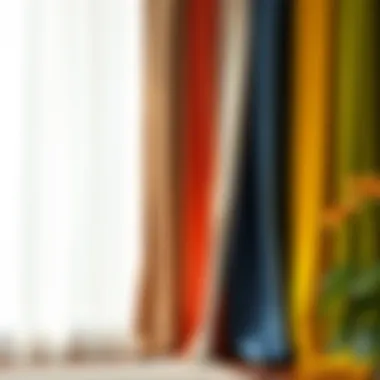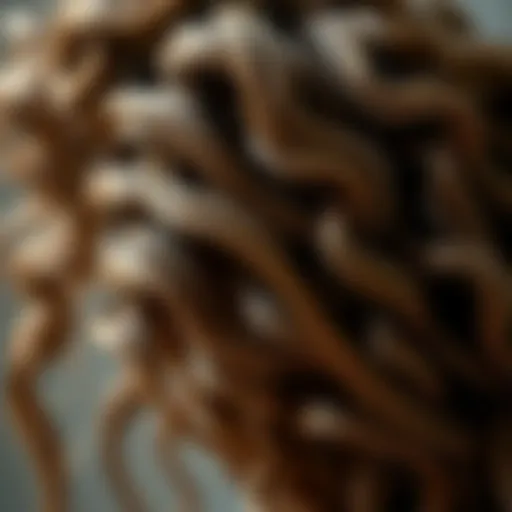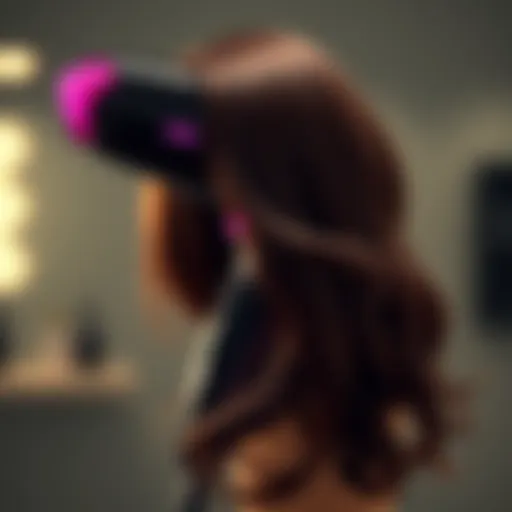Multicolor Curtains for Living Room: A Complete Guide


Intro
When it comes to decorating a living room, choosing the right curtains can often feel like searching for a needle in a haystack. Multicolor curtains are emerging as a bold trend, offering not just functionality but also a splash of artistic flair. They can transform a bland space into something vibrant and captivating. This guide takes a deep dive into the world of multicolor curtains, looking at how they can impact your living room's design.
As we explore this topic, you’ll find useful tips on styles and materials, placement strategies, and how to harmonize these vivid textiles with your existing decor. Whether you’re just starting to consider new curtains or you’re ready to dive into a full redesign, this guide aims to offer you valuable insights and practical knowledge. So roll up your sleeves; we’re going on a colorful journey through the intricate world of curtains.
Prelims to Multicolor Curtains
When it comes to interior design, curtains are often an afterthought, yet they wield tremendous power in shaping the overall ambiance of a room. This guide shines a light on multicolor curtains—those vibrant textiles that can breathe life into any living room. The thought of incorporating these bold pieces might feel daunting, but they offer an immediate way to infuse personality and flair into your space.
The Role of Curtains in Interior Design
Curtains play a fundamental role in interior aesthetics and functionality. They serve not only as a barrier to light and noise but also as a canvas to showcase your style. Think of curtains as the final brushstrokes in a carefully considered painting; their color, texture, and pattern can either harmonize with or contrast against other room elements, creating visual interest.
In a living room where people gather, curtains can set the mood—softening harsh sunlight, providing privacy, and pulling together disparate furniture styles. A well-chosen set can be the focal point of an otherwise neutral room or complement an intricate decor scheme. This versatility makes multicolor options particularly appealing. By mixing hues, patterns, and textures, one can convey a spectrum of emotions—from cozy and intimate to vibrant and energizing.
"The right curtain can elevate a living room from mundane to magnificent."
Overview of Multicolor Options
Multicolor curtains come in a plethora of styles and designs, providing an expansive range of options for any design aficionado. They are not limited to whimsical prints or clashing patterns; instead, they can serve as elegant statements that reflect sophistication.
- Patterns: From florals to geometric shapes, patterned multicolor curtains can transform a space. They often create a dynamic energy, appealing to those who love visual stimulation.
- Stripes: Striped designs can elongate a room and offer a contemporary twist. Choosing colors that align with existing furniture can create a seamless look.
- Ombre: The gradient effect found in ombre curtains adds a layer of depth, effortlessly blending colors and whispering subtle elegance.
- Block Colors: For minimalists, curtains that combine bold blocks of color can create a striking contrast against lighter walls.
Understanding these options allows one to select curtains that not only enhance but also elevate the functional decor of a living room. The subsequent sections will delve deeper into color theory, fabric selection, and practical tips for incorporating these stunning pieces into your home.
Understanding Color Theory
Color theory lies at the heart of interior design and is particularly significant when dealing with multicolor curtains. Understanding how colors interact can dramatically influence the atmosphere of a room and guide your choices in fabric and patterns. This section will explore the fundamental concepts of mixing colors and the psychological implications of color choices in home decor.
Mixing Colors: The Basics
To grasp the crux of color, one must grasp the fundamentals of mixing. The basic color wheel, consisting of primary colors – red, blue, and yellow – serves as a foundation. When these primary colors blend, they create secondary colors: green, orange, and purple. This interplay of hues carries its own rhythm, whether you choose to harmonize or contrast. Here are a few key points:
- Complementary Colors: These are colors that sit opposite each other on the color wheel. For instance, pairing blue curtains with orange walls offers a vibrant and dynamic feel.
- Analogous Colors: Located next to each other on the wheel, such as blue, blue-green, and green, these colors create soothing and cohesive looks, making them ideal for softly calming environments.
- Triadic Color Schemes: This method utilizes three colors that are evenly spaced on the wheel, like red, yellow, and blue. The balance this creates can liven up a living space without overwhelming it.
By understanding these basic relationships, you can select multicolor curtains that complement existing furnishings and help establish a desired mood.
The Psychology of Color in Home Decor
Colors are not merely aesthetic choices; they evoke emotions and set the tone for a space. The effects colors have on our psychology can significantly impact how we feel in our living rooms. For instance:
- Warm Colors: Reds, yellows, and oranges are associated with warmth and energy. When incorporated through multicolor curtains, they grab attention and encourage social interactions. Ideal for a lively family gathering!
- Cool Colors: Blues and greens often promote calmness and tranquility. These tones can help create a serene atmosphere, perfect for relaxation and unwinding after a long day.
- Neutral Colors: Shades like beige, gray, and white can act as a blank canvas, allowing other colors to shine. They also contribute to a sense of stability and comfort.
"Color is a power which directly influences the soul." – Wassily Kandinsky
Choosing curtains with colors that resonate with the emotions you want to evoke can refine the living room experience. It’s worth taking time to reflect on how each hue can affect mood and functionality.
Understanding color theory not only aids practical decisions but also enriches the aesthetic journey, helping to create living spaces that reflect personal styles and emotional atmospheres.
Types of Multicolor Curtains


Multicolor curtains serve as an artistic expression in a living room while fulfilling practical needs such as light control and privacy. Understanding the different types can help homeowners decide which style to adopt, blending functionality with aesthetics. Here are several critical elements to keep in mind when considering multicolor curtains:
Patterned vs. Solid Colors
When it comes to selecting the ideal curtains, homeowners often grapple with the choice between patterned and solid colors. Each option brings its unique advantages and considerations.
Patterned Curtains
Patterned curtains can transform a space, acting as statement pieces. They often feature elaborate designs, from floral to geometric shapes. Patterns can evoke different emotions, depending on their complexity. For instance, intricate paisley designs may impart a sense of elegance, while bold stripes could add a modern edge.
The key to using patterned curtains is to balance them with the rest of the room’s decor. Pair them with solid-colored furniture to avoid a chaotic look. However, when done right, they can actually tie a whole room together.
Solid Color Curtains
On the other hand, solid color curtains provide simplicity and versatility. They can either complement or contrast the existing color scheme of the room, offering a more understated backdrop to furniture and decor.
Solid colors tend to fit well in spaces where a calming atmosphere is desired. For example, soft hues like pastels can lend a tranquil feel, while deep colors such as navy or burgundy can make a bold statement. Also, they offer more straightforward coordination possibilities, as they blend in effortlessly with many styles.
Textured Fabrics for Visual Interest
When decorating with multicolor curtains, fabric texture shouldn't be underestimated. Various fabric textures, such as linen, velvet, and sheer, can add depth to window treatments, creating an engaging focal point within the room.
Layering and Mixing Textures
The beauty of textured fabrics lies in their capacity to create a dynamic atmosphere. Velvet curtains can provide a luxurious feel, while sheer fabrics allow light to permeate, softening the room's overall look. By layering different textures, one can achieve a rich visual array that's both captivating and sophisticated.
Utilizing textured curtains can also offer practical benefits—such as improved insulation and sound absorption—making them an excellent dual-purpose choice for a living room.
The Impact of Ombre and Gradient Styles
Ombre and gradient curtains have grown in popularity due to their unique approach to color application. These styles can create an illusion of depth and movement within a space, drawing the eye and boosting visual interest.
Visual Flow and Transition
When you opt for ombre curtains, you witness a gradual blending from one color to another; this can create a sense of flow in a room. For instance, transitioning from a deep blue at the top to a soft white at the bottom can add an element of serenity to the space.
Gradient styles allow for creative experimentation, as they can incorporate multiple colors in a singular selection. Perfect when matching various colors in your living room decor, they can be a fantastic bridge between disparate or complementary shades.
Incorporating ombre curtains can not only anchor a room's design but also serve as a conversation starter for guests.
By considering these various types of multicolor curtains, homeowners can make enlightened choices that enhance their living spaces, enriching both style and function.
Choosing the Right Fabric
Selecting the right fabric for multicolor curtains is crucial. The fabric sets the tone for your living room and can contribute significantly to the overall aesthetic. Different fabrics bring about various textures, weights, and patterns, all of which play an essential role in how light interacts with your space. Not to mention, some fabrics have better durability and are easier to clean than others. This section discusses common materials used for curtains, how to evaluate their durability, and tips for maintenance and cleaning.
Common Materials for Curtains
When exploring curtain options, understanding the common materials is fundamental. Each material has its distinct properties that can enhance the living room's charm:
- Cotton: This natural fiber is versatile and widely preferred for its breathability and ease of cleaning. Cotton curtains tend to have vibrant prints and can be machine washed, making them practical for daily use.
- Linen: Known for its lightweight and airy quality, linen looks stunning and adds a touch of sophistication. However, linen can wrinkle easily and may require more diligent care.
- Silk: A luxurious choice, silk curtains can make any room feel more elegant. They drape beautifully but often require dry cleaning, making them less convenient for high-traffic areas.
- Polyester: Often used for its affordability, polyester curtains are durable and resistant to wrinkling and fading. These fabrics often come in various prints and patterns, making them a popular choice for multicolor options.
- Velvet: If you're aiming for a plush, opulent feel, velvet curtains are an ideal choice. They absorb light and can help reduce noise, but they might need a little extra care to maintain their appearance.


Durability Considerations
Durability is an essential factor when selecting fabric. You want curtains that can withstand daily wear without fraying or fading. Some considerations include:
- Colorfastness: Ensure that the fabric's color won’t bleed or fade when exposed to sunlight. Ultra-violet rays can be unforgiving, especially in lighter colors.
- Wear Resistance: Fabrics like polyester and blends tend to hold up better under stress, making them suitable for households with pets or children.
- Cleaning Ease: Fabrics that are machine washable can save time and effort compared to those that require dry cleaning or hand washing. Check if the fabric is treated or coated to resist stains or water, enhancing its longevity.
Maintenance and Cleaning Tips
Getting the right fabric is only part of the equation; knowing how to care for it is just as vital. Here are some practical maintenance tips:
- Regular Dusting: Dust can accumulate on any fabric. Use a vacuum cleaner with an upholstery attachment regularly to keep curtains looking fresh.
- Spot Cleaning: For minor stains, tackle them immediately. Blot the stain instead of rubbing it, which can spread it further.
- Washing Instructions: Always refer to the care label. Some fabrics can withstand machine washing; others may need a gentle hand wash.
- Use of Liners: Consider adding a lining to your curtains. This can add extra insulation, prevent fading from the sun, and make cleaning simpler as the liner can be washed separately.
Keeping your curtains in good condition not only enhances the ambiance of your living room but also prolongs the lifespan of your investment in decor.
Understanding these aspects of choosing and maintaining fabrics will ensure that your multicolor curtains not only enhance the look of your living space but also hold up over time.
Incorporating Multicolor Curtains into Design Schemes
Incorporating multicolor curtains does more than just dress the windows; it opens up a realm of design possibilities that can elevate the entire atmosphere of your living room. These curtains act as a visual anchor in a space, offering both aesthetic appeal and practical function. The vibrancy of multicolor curtains can set the mood, influence perceptions of space, and enhance or diminish natural light. Understanding how to effectively weave these textiles into your overall design scheme is paramount to achieving a cohesive and inviting environment.
Balancing Colors in a Room
Striking a balance in color is akin to finding the right harmony in music. When you introduce multicolor curtains, it’s essential to consider the color palette of your entire living space. The aim isn't to overwhelm the senses but rather to create a dialogue between different elements.
- Color Wheel Insights: Familiarize yourself with the color wheel. Choosing curtains that are complementary to your walls and furniture can be a real game changer. If your walls are painted in a soft beige, a set of curtains splashed with earth tones or muted jewel tones can tie everything together.
- Visual Weight: A room full of deep colors may risk feeling heavy. If your curtains are vibrant or dark, consider balancing them with lighter furniture or decor. This addition can help lift the space, ensuring it doesn’t feel like it's closing in on you.
- Textiles and Patterns: Mix and match patterns judiciously. If your curtains have bold prints, aim for subtle patterns on throw pillows or rugs. This interplay emphasizes diversity without devolving into chaos.
Complimentary Colors and Styles
Playing with complementary colors brings depth to your living room design. When selecting multicolor curtains, consider styles that pair well with your existing decor. Here are a few pointers:
- Shades and Tones: Get a sense of the different shades within your curtain colors. If your curtains feature reds and blues, a well-placed blue vase or a red accent chair can illustrate a beautiful connection.
- Mixing Styles: Don’t shy away from mixing modern and traditional styles. A classically patterned curtain can look stunning against contemporary furnishings. This contrast creates a dynamic space that is visually interesting yet not jarring.
- Consider the Mood: Each color dictates a specific vibe. Warm tones can create a cozy atmosphere, while cool tones often convey tranquility. Ensure your choice aligns with the impression you wish to foster.
Ventilation and Lighting Considerations
When hanging multicolor curtains, it’s crucial to pay attention to ventilation and lighting—two elements that can dramatically alter both appearance and environment.
- Natural Light Flow: Think about how your curtains interact with natural light. Lightweight fabrics featuring vibrant colors can filter sunlight in a charming manner, creating dreamy shadows. Heavy or dark curtains may block light and make a space feel smaller, so choose wisely.
- Room Functionality: The function of your living room will dictate choices as well. If your space is primarily used for social gatherings, opt for lighter fabrics that encourage brightness. For a cozy reading nook, heavier fabrics can provide warmth and solitude.
- Energy Efficiency: Lastly, don't forget energy efficiency. Blackout curtains can be a boon during hot summer days or chilly winters. They can equalize temperatures, providing comfort all year round and allowing you to play with colors without worrying about the impact on your energy bills.
Incorporating multicolor curtains into your living room isn’t merely about aesthetics; it’s a carefully crafted strategy that involves balancing colors, knowing complementary styles, and considering practical aspects like ventilation and lighting. The right curtains have the potential to breathe life into your space, making it both inviting and uniquely reflective of your taste.
Practical Tips for Hanging Multicolor Curtains
Hanging multicolor curtains isn’t just about aesthetics; it’s a fine art that speaks volumes about your design sensibility. While the vibrant hues and patterns can draw the eye, their placement can make or break a room’s overall vibe. In this section, we’ll unveil essential tips that ensure your curtains not only look good but also enhance your living space’s functionality and beauty.
Ideal Heights for Hanging
Determining the right height for your curtain rods can seem trivial, but it holds significant sway over your room's perceived spaciousness and style. The common wisdom suggests hanging curtains just above the window frame, but let’s dig a little deeper:
- Height Impact: Mounting rods higher than the window frame contributes to an illusion of height. When you hang curtains closer to the ceiling, the area feels larger and more open.
- Length Matters: Floor-length curtains have a dramatic look; they can either pool on the floor or just gently graze it, depending on the style you are aiming for. Pooling creates a relaxed vibe, while a slight break at the floor lends a tailored feel.
Finding the perfect height is often a personal choice that depends on the mood you want to create. Many designers recommend measuring about 4 to 6 inches above the window frame, giving that extra boost to the visual appeal.


"A well-hung curtain can transform the entire atmosphere of your space, making it feel curated and intentional."
Layering with Other Window Treatments
Layering offers a unique way to play with texture, light filtration, and style, especially with multicolor curtains. Here are some points to consider when combining treatments:
- Mixing Styles: Try pairing sheer curtains with thicker, patterned multicolor styles. This way, you can have privacy without sacrificing brightness during the day. Sheers can diffuse light beautifully, allowing you to maintain an airy atmosphere while also adding a dash of drama with your multicolor curtains.
- Color Coordination: Consider colors that resonate well with each other. For instance, if your multicolor curtains have bold reds and blues, try adding a subtle gray or white sheer for balance. Pulling colors from the curtain into the sheer treatment creates a visual harmony.
Incorporating different types of window treatments not only enhances the room's style but also its functionality. Think about what you want to achieve: is it more light, more privacy, or perhaps just a splash of color? Whichever it is, layering allows you to weave your personal design narrative into the space, making it uniquely yours.
Attention to detail in hanging and layering ensures that your multicolor curtains are not just an afterthought but a dominant feature that draws the eye and adds to the sophisticated charm of your living room.
The Influence of Cultural Trends
Cultural trends play a pivotal role in shaping interior design, particularly when it comes to the vibrant world of multicolor curtains. To modern homeowners and decorators alike, integrating culturally inspired textiles not only adds aesthetic value but also reflects personal identity and heritage. Such integration allows rooms to resonate with deeper meaning and vibrancy, transforming spaces into stories captured within fabric.
The significance of cultural trends in choosing multicolor curtains can be broken down into a few elements:
- Cultural Expression: Each culture has distinct patterns, colors, and weaves that tell a story. Choosing curtains that echo these influences can add character—think Moroccan prints or Indian block-prints—that inject a bit of global flavor into your living room.
- Trend Fusion: Understanding which cultural trends are resonating with popularity can open up avenues for fresh design ideas. For instance, embracing Scandinavian minimalism alongside bold African geometric patterns offers a contemporary fusion that’s harmonious and lively, keeping the space fresh yet grounded.
- Ethical Considerations: In today’s design landscape, seeking ethically produced textiles becomes paramount. Many contemporary brands cater specifically to sustainable practices while incorporating traditional designs, allowing for a more responsible selection of multicolor curtains. By prioritizing ethical choices, homeowners successfully contribute to sustainable cultural narratives.
Ultimately, understanding the influence of cultural trends promotes a richer approach to designing living spaces. The end goal is creating an environment that is as welcoming as it is engaging, proving that curtains aren’t just fabric, but a canvas of culture and comfort.
Global Patterns and Fabrics
When one thinks about global patterns and fabrics for curtains, the options can be a feast for the eyes. Different nations have a treasure trove of designs that reflect their unique histories and craftsmanship.
- Asian Silks: Known for their luxurious feel, silk curtains often incorporate vibrant motifs depicting elements from nature, such as lotus flowers, which can transform a drab room into an exotic paradise.
- African Kente Cloth: Bright colors and patterns can speak to a celebratory spirit. Kente cloth curtains bring a touch of pride and a pop of color, transforming the atmosphere into a festival of hues.
- European Vintage Patterns: Countries like France often showcase intricate designs, featuring floral prints or baroque styles in rich colors. Such vintage patterns can add a touch of old-world charm, making a space feel more inviting.
Incorporating these global patterns not only adds visual interest but also serves as an educational piece, creating an atmosphere where stories and histories blend harmoniously.
Contemporary Designs vs. Traditional Styles
Navigating between contemporary and traditional styles in multicolor curtains can be like walking a tightrope. Each style possesses its own set of advantages, appealing to various tastes and furnishing styles.
- Contemporary Designs: Characterized by clean lines and bold colors, contemporary curtains often embrace geometric or abstract motifs. They tend to work well in modern spaces that favor minimalism or eclectic decor. For those who wish to harness a sense of lightness and airiness, these designs can perform wonders.
- Traditional Styles: More ornate and intricate, traditional curtains often feature elaborate patterns and rich fabrics. Elements like damask or paisley can evoke a sense of history and elegance, allowing homeowners to connect with timeless sophistication.
Blending these styles can yield astonishing results. Take, for example, a living room with sleek furniture in neutral tones. Paired with traditional-patterned curtains, one can achieve a striking juxtaposition, giving the room depth while retaining a contemporary feel. Thus, exploring both styles ensures versatility in achieving the desired ambiance and functional purpose of your living space.
"Cultural trends in design can turn a house into a home, reflecting its inhabitant's story and the tapestry of their life’s experiences."
Closure
As we wrap up our exploration of multicolor curtains, it's vital to underscore their dynamic role in modern interior design. These vibrant textiles are not merely functional; they’re transformative, giving a fresh spin to any living space. The key to leveraging multicolor curtains effectively lies in understanding their aesthetic versatility and the emotional resonance they can create.
Multicolor curtains are a simple way to inject life and character into a room, reflecting personal style and enhancing overall ambiance.
Key Takeaways on Multicolor Curtains
- Versatility in Design: Whether you're drawn to bold patterns or soft hues, multicolor curtains allow you to express your style while harmonizing with existing decor.
- Color Psychology: The colors in your curtains can influence mood and perception. For example, warm hues like reds and oranges can evoke energy, while cooler shades like blues can create a serene atmosphere.
- Material Matters: The type of fabric you choose can affect not only the look but also the performance of your curtains. From lightweight sheers to heavy drapes, materials can dictate how light enters and how rooms feel.
- Cohesion is Key: While these curtains can be vibrant, they need to work with furniture and accessories to avoid visual clutter. Think of your living room as a well-composed painting where every element creates harmony.
Final Thoughts on Creating a Cohesive Look
When incorporating multicolor curtains, consider them as part of a larger narrative within your living space. Start by assessing the existing color palette of your room. Effective use of complementary hues within your curtains can tie everything together seamlessly.
Additionally, consider how layering your curtains with other treatments like blinds or sheers can add depth and texture to your windows. This approach not only enhances visual interest but also offers functionality, such as improved light control and privacy.
Ultimately, when selected and styled thoughtfully, multicolor curtains can elevate your living room from ordinary to extraordinary. They are indeed a statement piece, capable of conveying your unique sensibility while ensuring comfort and warmth in your daily life.















